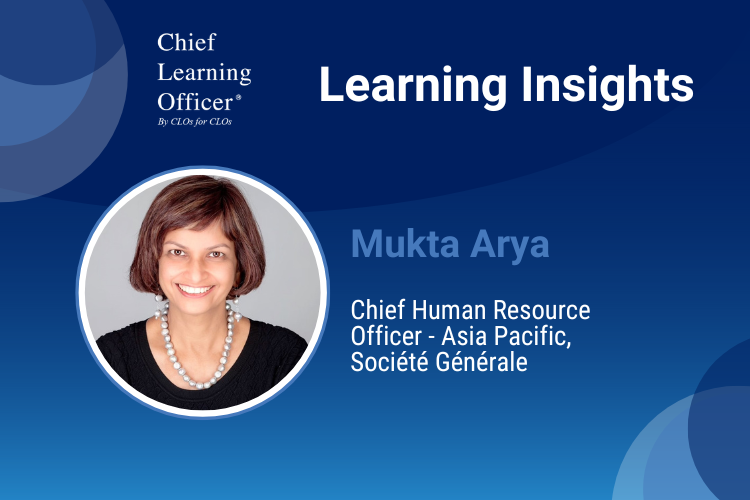Chief Learning Officer’s “Learning Insights” series is dedicated to showcasing the thoughts and career journeys of chief learning officers and learning executives—the tireless trailblazers who are transforming the landscape of corporate learning and workforce development. In this Q&A series, we garner strategic insights, innovative approaches and challenges overcome from visionary leaders worldwide.
What initially drew you to a career in learning and development, and how have your experiences evolved over the years?
The fact that the learning and development field is future-focused and positive initially drew me to L&D. I have been in generalist HR positions and learning positions in my career and in my opinion, L&D is an important part of talent management in organizations and it has become all the more integrated with marked impact. It is not a “nice to have” anymore, but a necessity, and the lack of L&D in organizations can be detrimental to employee engagement and career growth.
What key initiatives have you implemented as a learning leader to drive employee development and foster a learning culture?
As a learning leader, I have implemented the following initiatives over the years to drive employee development and foster a learning culture:
- Mentoring programs (Traditional, reverse and group mentoring)
- CEO club for high potentials
- Talent development programs for managing directors and Directors (Destiny X and IMPACT)
- Peer coaching for managers
- Internal coaching
- Introduction of 13 digital learning programs
- Measurement using ROI methodology
- Programmes on ESG and data
What is the most impactful learning program you’ve introduced in your organization, and how has it contributed to employee growth and business success?
The most important learning program that I have introduced is the “CEO Club” in APAC. Designed for high-potential employees, this program, which is run every year with 12-15 participants, works closely with the CEO of APAC and senior management, to learn management skills by carrying out an action learning project.
Over the years, the participants of the program have been promoted to key positions and have contributed tremendously to the growth of the organization. This management development program has been running since 2010 and has been very successful with high engagement and results. We did ROI study on the batches and it is at 140 percent as of now. We also found that the difference between the control group and the CEO Club participants has increased by 20 percent, which is evidence that the ROI is due to the program and not contaminated by other factors. All in all, it is our flagship program and it continues to help employees develop and help the business succeed.
What is a common misconception people might have about the L&D function, and how do you address it?
The common misconception people might have about the L&D function is that it is for those who prefer an easy work life and it does not require specific skills. To address it, I prefer to show my skills through action. First, make sure that L&D professionals understand the business and that the needs analysis is based on this understanding of the business. Then the offerings are discussed, sometimes co-created with business using design thinking and with the involvement of employees. Third, with specific certifications like coaching, MBTI and Enneagram, the development offerings are provided with the help of internal trainers. Once employees see the value, they understand that this field is not a generic skill, it is acquired and is a true combination of science and art.
What excites you the most about the future of workplace learning, and how are you preparing your organization to adapt to the changing landscape?
What excites me most are the vast opportunities that we have with new technologies like Virtual Reality and Augmented Reality to make the learning experience not only effective but also fun and engaging. This means that we can expand our modes of delivery, from face-to-face, e-learning and virtual learning to newer ones in order to cater to different learning styles and generations. At my organization, we are quite advanced in this part and working on future initiatives.
What essential qualities or skills make a successful L&D leader, and how do you cultivate these traits in yourself and among your team?
A successful L&D leader is an open-minded individual who is curious and willing to experiment with new ideas, concepts and methodologies. To cultivate these traits, continuous learning is a very effective way- not only through structured training programs but by reading about the world around us, attending seminars, meeting professionals from different fields and most importantly being present at the moment.
I find creative hobbies like watching movies and plays, handicrafts, playing musical instruments, etc., are great for developing different perspectives, and it ultimately helps in developing unique skills as an L&D leader. An L&D leader should also be savvy with numbers and new technologies and should be able to provide ROI for the initiatives implemented. Tech savviness and digital literacy are non-negotiable skills.
What game-changing advice would you offer if you could go back in time and mentor your younger self?
I would advise my younger self to become proficient in data from the early stages of my career. In any field and especially in HR and L&D, data is extremely important to understand the impact of initiatives and as HR professionals, if we want to be relevant, data proficiency with a storytelling approach is the way to go!
What do you feel is currently the single biggest challenge facing L&D professionals and the industry as a whole?
In my opinion, the single biggest challenge facing L&D professionals is the shrinking attention span that employees seem to have due to various reasons: Changing work environment with constant reshuffling, an overload of information, multiple channels of learning and many more. With the limitation of attention span, it has become increasingly difficult to attain the objectives that any learning program must have—deep learning with engagement. There are various ways L&D professionals are combating this with their creativity, but it is not easy.
We’re always looking to showcase innovative tools and technologies. Can you share one work or learning tech product or platform that has significantly improved your work processes and why you find it valuable?
I find tools like Tableau or Power BI, very useful for people analytics. We have used Tableau for many years for people data and this has really helped the HR function to become fact-based and analytical. The diagnostics really helped in understanding the real people landscape and helped make decisions related to employees, in an effective manner.
The other tool is called ACE by 365Talents. It’s a tool for internal mobility and really helps in finding talents across the globe with keyword searches. The tool also throws up relevant job opportunities in the company which helps in our internal mobility efforts.
Interested in being featured in our “Learning Insights” series? Please complete this FORM.















